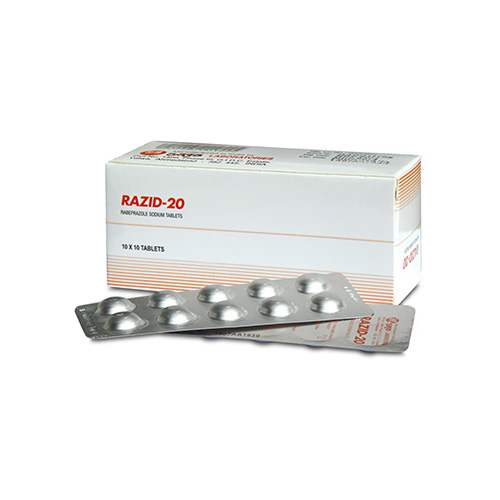
RAZID 20 Tablet
Therapeutic Class
Antacids, Antireflux Agents & Antiulcerants
Indications
RAZID tablets are indicated for the treatment of: Active duodenal ulcer Active benign gastric ulcer Symptomatic erosive or ulcerative gastro-oesophageal reflux disease (GORD). H. Pylori-positive duodenal ulcers, as part of the eradication programme with appropriate antibiotics. Maintenance treatment of healed erosive or ulcerative GORD. Efficacy has not been demonstrated for periods exceeding 12 months.
Chemical Composition
Each enteric coated tablet contains:
Rabeprazole Sodium : 20 mg
Excipients : Q.S.
Colour : Sunset Yellow
Packaging
10 x 10's/ Box
Dosage & Administration
Active Duodenal Ulcer and Active Benign Gastric Ulcer: 20 mg to be taken once daily in the morning. Erosive or Ulcerative Gastro-Oesophageal Reflux Disease (GORD): 20 mg to be taken once daily for four to eight weeks. Gastro-Oesophageal Reflux Long-term Management (GORD Maintenance): For longterm management up to 12 months, a maintenance dose of RAZID 10 mg once daily can be used. Some patients may respond to a maintenance dose of 10 mg/day. Eradication of H. Pylori: RAZID 20 is indicated for H. Pylori-positive duodenal ulcers, as part of the eradication programme with appropriate antibiotics.
Contraindications
RAZID 20 is contra-indicated in: patients with known hypersensitivity to Rabeprazole sodium, substituted Benzimidazoles or to any excipient used in the formulation. Pregnancy and lactation.
Warning & Precautions
Symptomatic response to therapy with Rabeprazole Sodium does not preclude the presence of gastric or oesophageal malignancy, therefore the possibility of malignancy should be excluded prior to commencing treatment with RAZID 20. Although no evidence of significant drug related safety problems was seen in a study of patients with mild to moderate hepatic impairment versus normal age and sex matched controls, the prescriber is advised to exercise caution when treatment with RAZID 20 is first initiated in patients with severe hepatic dysfunction.
Side Effects
The most common adverse events were headache, diarrhoea and nausea. Other adverse events were rhinitis, abdominal pain, asthenia, flatulence, pharyngitis, vomiting, non-specific pain/back pain, dizziness, flu syndrome, infection, cough, constipation and insomnia. Further less frequent adverse events were rash, myalgia, chest pain, dry mouth, dyspepsia, nervousness, somnolence, bronchitis, sinusitis, chills, eruction, leg cramps, urinary tract infection, arthralgia and fever. In isolated cases, anorexia, gastritis, weight gain, depression, pruritus, vision or taste disturbances, sweating and leucocytosis have been observed. Increased hepatic enzymes have been observed in 2% of patients. There have been reports of thrombocytopenia, neutropenia, and leukopenia.
Drug Interaction
Rabeprazole Sodium, as is the case with other members of the Proton Pump Inhibitor (PPI) class of compounds, is metabolised through the cytochrome P450 (CYP450) hepatic drug metabolising system. Studies in healthy subjects have shown that Rabeprazole Sodium does not have clinically significant interactions with other drugs metabolised by the CYP450 system, such as Warfarin, Phenytoin, Theophylline or Diazepam. Rabeprazole Sodium produces a profound and long lasting inhibition of gastric acid secretion. An interaction with compounds whose absorption is pH dependent may occur therefore the potential for such interaction was investigated. Co-administration of rabeprazole Sodium results in a 33% decrease in ketoconazole levels and a 22% increase in trough Digoxin levels in normal subjects. Therefore individual patients may need to be monitored to determine if a dosage adjustment is necessary when such drugs are taken concomitantlywith RAZID In clinical trials, antacids were used concomitantly with the administration of RAZID 20 and, in a specific study designed todefine this interaction, no interaction with liquid antacids was observed. There was no clinically relevant interaction with food.In vitro studies with human liver microsomes indicated that Rapebrazole Sodium is metabolised by isoenzymes of CYP450 (CYP2C19 and CYP3A4). The studies suggest a low interaction potential; however the effect on cyclosporin metabolism is similar to that observed for other proton pump inhibitors.

